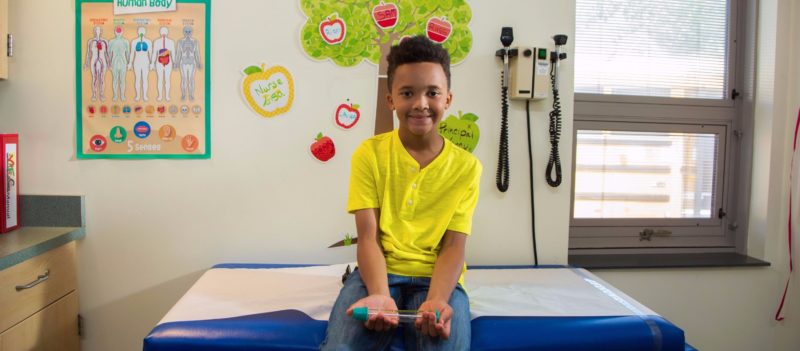The Centers for Disease Control states that 6.2 million children currently have asthma. Of those, it is estimated that anywhere from 5-20% of them have severe, complex and/or difficult-to-treat asthma.
We define difficult-to-treat asthma by the symptoms patients are experiencing. The four hallmarks of asthma are coughing, wheezing, shortness of breath and chest pain. So your child is at risk for having uncontrolled asthma if he has had:
- Symptoms several times a week despite being on multiple asthma medications
- An ER visit or hospitalization for asthma in the last year
- Oral steroids two or more times for asthma in a year
While there are many cities across the country that have a high incidence of asthma, Greater Cincinnati’s overall rate of pediatric asthma is more than twice the national average.
Greater Cincinnati’s geography plays a huge role in this rate, with the low-lying smog-trapping hills, three heavily traveled interstate highways, and a high rate of allergen exposure. A trifecta that is ripe for causing problems for asthmatic children.
What may be surprising to hear is that some children will have difficult-to-treat asthma, despite doing all of the right things. Meaning, they reduce their exposures to modifiable triggers, take all of their medications, keep their doctors’ appointments, and still have problems. Why is this?
Reasons Why Kids Have Difficult-To-Treat Asthma
- Underlying causes. Some children may have an underlying disease such as gastric reflux, allergies, or obesity that can make asthma symptoms worse.
- Challenging environments. Some environmental exposures simply aren’t possible to change. For instance, it may not be possible to move away from a city such as Cincinnati where the overall air quality is poor. If you live in an old home, like many in Cincinnati, it is more likely to contain things like mold, cockroaches and mice. These are known asthma and allergy triggers.
- Psychosocial barriers. What patients believe about themselves and their disease can play a role in how they fare. Meaning, some patients don’t believe they’ll be able to get their asthma under control, so it never does. Or they don’t think it’s possible to be an athlete with asthma. Some patients have depression or anxiety that can be a barrier to asthma treatment and adherence.
- Needing targeted medications. Despite trying different kinds of medicines, is your child still having asthma symptoms? We’ve found that different types of medications are better at treating certain categories of asthma. Once we can categorize children based on their airway inflammation, we can craft a better combination of medicines for them.
- Demographic factors. Boys tend to have more asthma problems when they’re of school age. The late teenage years are worse for girls. Some ethnic backgrounds have worse underlying or severe asthmatic disease. We don’t know how these factors contribute, but they’re important to know when trying to understand the overall asthma picture.
We’ve made some significant improvements for kids with difficult-to-treat asthma, but there is more work to be done. As we are partnering with families and schools to address the reasons why children have difficult-to-treat asthma (as outlined above), we aim to improve outcomes further.
If you are concerned that your child has difficult-to-treat asthma, please speak with your child’s doctor. He or she may recommend a referral to an asthma specialist.
For more information about our Asthma Center, Difficult-to-Treat Asthma clinic, or to request an appointment, please call 513-636-6771. We provide a comprehensive, multidisciplinary team approach to caring for children with difficult-to-treat asthma. It is staffed by two pulmonologists, an allergist, a health psychologist, a social worker, and experienced nurses.






